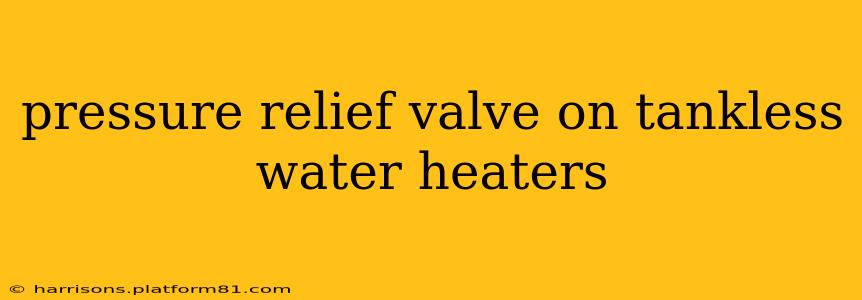Tankless water heaters, while efficient and space-saving, require careful attention to safety features. Among the most crucial is the pressure relief valve (PRV), a vital component that protects your system from potentially dangerous pressure build-up. This comprehensive guide delves into everything you need to know about the pressure relief valve on your tankless water heater, ensuring you understand its function, maintenance, and troubleshooting.
What is a Pressure Relief Valve (PRV) and Why is it Important?
A pressure relief valve (PRV), also known as a temperature and pressure relief valve (T&P valve), is a safety device designed to automatically release excess pressure and temperature from your tankless water heater. This prevents potentially hazardous situations like tank rupture or scalding hot water discharge. In a tankless system, excessive pressure can build up due to various factors, including:
- High Water Pressure: If your home's water supply pressure is excessively high, it can overload the tankless heater.
- Thermal Expansion: Water expands when heated. In a closed system, this expansion can significantly increase pressure.
- System Blockages: A blockage in the water lines can restrict flow and lead to pressure build-up.
- Malfunctioning Components: Problems with the heating element, flow sensor, or other internal components can contribute to excessive pressure.
How Does a Pressure Relief Valve Work on a Tankless Water Heater?
The PRV on your tankless water heater is typically a spring-loaded valve. When the pressure inside the system exceeds a pre-set limit (usually around 150 PSI), the valve opens, releasing hot water and pressure until the system returns to a safe level. This prevents damage to the heater and safeguards against potential injury. The released water is typically directed to a drain pipe.
How Often Should I Test My Tankless Water Heater's Pressure Relief Valve?
Testing your PRV is crucial for ensuring its functionality and preventing potential problems. While the frequency varies depending on local codes and manufacturer recommendations (consult your owner's manual!), a good rule of thumb is to test it at least once a year. This usually involves manually activating the lever on the valve, causing a small amount of water to be released. If no water is released, the valve may be malfunctioning and needs replacement.
What Happens if My Pressure Relief Valve Malfunctions?
A malfunctioning PRV can lead to serious consequences, including:
- System Damage: Excessive pressure can damage internal components of the water heater, leading to costly repairs or replacement.
- Water Leaks: A faulty valve might leak constantly, leading to water damage and potential mold growth.
- Safety Hazards: A build-up of pressure could result in a catastrophic failure of the tankless heater, posing a significant safety risk.
How Can I Tell if My Pressure Relief Valve Needs Replacing?
Several signs indicate your PRV may need replacing:
- Constant dripping: A persistently leaking valve indicates a problem with the sealing mechanism.
- Failure to release water when tested: If manually activating the lever doesn't release water, the valve is likely malfunctioning.
- Visible damage: Physical damage to the valve, such as cracks or corrosion, suggests it needs replacement.
How Do I Replace a Pressure Relief Valve on My Tankless Water Heater?
Replacing a PRV requires some plumbing skills and familiarity with your specific tankless water heater model. Consult your owner's manual for detailed instructions or seek professional help from a qualified plumber. Improper installation could compromise safety and void your warranty.
What Size Pressure Relief Valve Do I Need for My Tankless Water Heater?
The required size of the PRV depends on the heating capacity and plumbing configuration of your tankless water heater. Always refer to your water heater's manufacturer's specifications to determine the correct size. Using an incorrectly sized valve can be dangerous and ineffective.
How Much Does it Cost to Replace a Pressure Relief Valve?
The cost of replacing a PRV varies, depending on the cost of the valve itself, labor costs (if you hire a plumber), and your location. However, it is generally a relatively inexpensive repair compared to the potential cost of damage caused by a failed PRV.
This guide provides a comprehensive overview of pressure relief valves on tankless water heaters. Remember, safety is paramount. Regular maintenance and prompt attention to potential problems are essential for ensuring the safe and efficient operation of your system. Always consult your owner's manual and seek professional assistance when needed.
